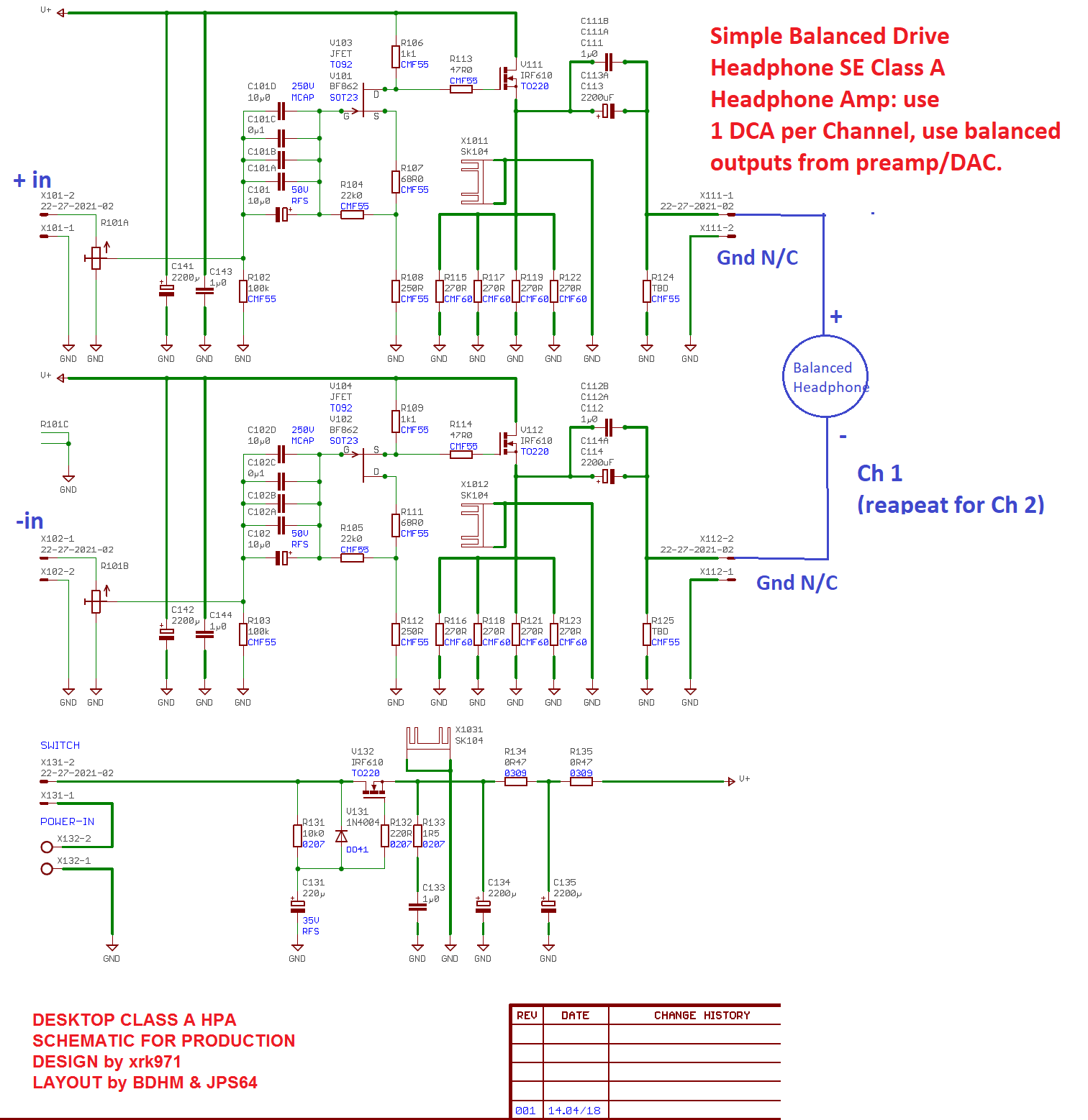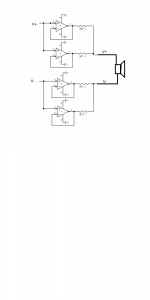One of the first examples I found of a DIY Fully Balanced amp was with XRK's DCA HPA, the simplicity of it was very surprising, its just 2 amp driving either end of a driver, relying on the differential input signal to work:

I was wondering if a similarly simple design is possible with op amps,
this an example based on O2 amp output buffer:

what are the issues with this, if any?
DC appears to be a risk with XRKs design, but only in the event of malfunction.
edit: or infact DC is always present on the DCA output in single ended mode and requires large coupling caps, where balanced mode infact makes it possible to remove these output caps completely. the OPA1622 has zero (max 0.2mV) DC offset so maybe its a not problem for this.
I was wondering if a similarly simple design is possible with op amps,
this an example based on O2 amp output buffer:

what are the issues with this, if any?
DC appears to be a risk with XRKs design, but only in the event of malfunction.
edit: or infact DC is always present on the DCA output in single ended mode and requires large coupling caps, where balanced mode infact makes it possible to remove these output caps completely. the OPA1622 has zero (max 0.2mV) DC offset so maybe its a not problem for this.
Last edited:
Certainly its possible with opamps. The issue is just that the power is quadrupled - double current and double voltage. Which presents half the load impedance to the opamps. So if the O2 were (say, I dunno its spec) rated to drive 32ohm when driven normally, you'd need to stick to 'phones which are 64ohms or higher. Or you could add more paralleled opamps to increase the current rating.
Certainly its possible with opamps. The issue is just that the power is quadrupled - double current and double voltage. Which presents half the load impedance to the opamps. So if the O2 were (say, I dunno its spec) rated to drive 32ohm when driven normally, you'd need to stick to 'phones which are 64ohms or higher. Or you could add more paralleled opamps to increase the current rating.
The plan was to use 4 OPA1622 chips per channel (8 single op amp per stereo channel, 4 per differential channel), the current ''amplifier'' im using is exactly that but with 8 single ended op amps per channel and it works fantastically.
oh cool, the OPA1622 version will be a great amp if you get round to finishing.My dual OPA1688 should be able to work well too - the single side layout for home etching are available in the
the VSON package is a nuisance, Im using the chinese DIP8 adapted version of 1622 for this stuff.
The OPA1688 had zero DC offset when I ''rolled'' it in the O2 amp, what is the causing the need for large output coupling caps here?
Those are optional as DC blocker protection for people who fear a catastrophic malfunction that would send full rail 18V to their beloved cans. Could use a DC safety circuit with relay but I was trying to keep it simple.what is the causing the need for large output coupling caps here?
Could use a DC safety circuit with relay but I was trying to keep it simple.
understood, its a single sided PCB meant for home etching after all.
I tried the OPA1622 in balanced configuration today, it was fairly simple to convert the 8PC single ended amp to 4+4PC balanced instead of building an entirely new amp with no idea if it will work well (or at all).
The sound is extraordinarily good, very open and holographic sound. perceivable distortion appears much lower and drivability seems much better, for high impedance dynamics and low impedance planar.
Nice work Laserscrape! is this 1622 your own design or you took a commercial amp and applied one amp for +ve and other amp for -ve?
Nice work Laserscrape! is this 1622 your own design or you took a commercial amp and applied one amp for +ve and other amp for -ve?
I guess its my own design in the sense that its not an exact copy of another existing amp but to call it a design is an overstatement, there is nothing more to it than the schematic in the first post with twice as many op amps, ... really, thats it. designed to suit very specific conditions.
power supply is dual TPS7A4701/3301 supply
You know, one can do this trick with any two sets of stereo amps. Just make some adapter cables to let a balanced source drive one amp, connect the left and right outs to drive one can, and set up an identical amp to drive the other can. Use balanced source for volume control and leave both amps on full volume.
This will work with for example, a pair of FIIO A5's each with an LME49600 and +/-11v supply. That would rock pretty hard.
This will work with for example, a pair of FIIO A5's each with an LME49600 and +/-11v supply. That would rock pretty hard.
Op-amps will drive a headphone OK.
I used an op-amp with series resistor on my headphones for a mobile disco.
Despite disco putting out 200WRMS I could still hear the headphones.
I put one record deck through the left headphone speaker and the other through the right speaker. Wasn't massively loud but passable.
I used an op-amp with series resistor on my headphones for a mobile disco.
Despite disco putting out 200WRMS I could still hear the headphones.
I put one record deck through the left headphone speaker and the other through the right speaker. Wasn't massively loud but passable.
its a very cool trick that probably 90% of audio enthusiasts dont realise.You know, one can do this trick with any two sets of stereo amps. Just make some adapter cables to let a balanced source drive one amp, connect the left and right outs to drive one can, and set up an identical amp to drive the other can. Use balanced source for volume control and leave both amps on full volume.
This will work with for example, a pair of FIIO A5's each with an LME49600 and +/-11v supply. That would rock pretty hard.
Maybe because of a lack of interest in balanced, the general assumption seems to be that balanced amps are not necessary/gimmicky, a lot confusion between balanced transmission and balanced amps.
Maybe some engineers dont think its important but I couldnt ever go back to single ended after experiencing it, and this amp is such a perfect example of SE vs balanced since it was an existing SE amp cut in half instead of doubling it, which rules out the improvements being due to increased power output
- Status
- Not open for further replies.
- Home
- Amplifiers
- Headphone Systems
- ''Fully balanced'' headphone buffer with op amps?